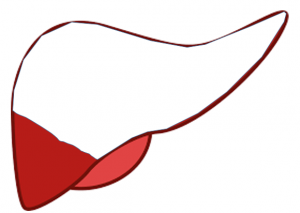2 Liver dysfunction
With liver dysfunction, problems can arise with energy levels and energy reserves, vitamin and mineral deficiencies, protein levels, coagulation, toxins, and drug effects.
The liver does have a very large functional reserve. It can still function normally with only 25% of “good” liver remaining. The liver can actually regrow itself (this works well for liver transplants).

Energy levels
Since the liver controls our metabolism, with liver dysfunction we can run out of energy. Clinical signs include weakness, fatigue and seizures.
Nutrient storage
Liver disease can lead to issues with nutrient storage. Symptoms may develop due to low levels of copper, iron and vitamins. Scurvy (deficiencies in vitamin C) can occur with liver disease.
Bile Production and Loss
With liver disease, the feces may be pale (not bile colored), fatty and smelly due to limited fat digestion. Weight loss usually accompanies liver disease due to lack of fat absorption.
Enterohepatic recirculation may be limited with bile salts collecting elsewhere in the body and/or not being available for reuse.
Protein Production
Less liver function means fewer proteins produced. This can impact oncotic pressure, coagulation, and other functions where proteins are required.
Edema occurs due to the lowered oncotic pressure. Hemorrhaging and bruising are evident with limited coagulation proteins.
Hyperlipidemia (high lipid levels in blood) may be observed. The lipids also accumulate in the liver causing more damage.
Detoxification
Many agents are not being detoxified. The urea cycle and ammonia metabolism are disrupted. These compounds and others (amino acids) can act as neurotransmitters, leading to neurological signs related to liver dysfunction.
Drug metabolism
Products aren’t excreted normally, leading to build up in organs and the blood. Drugs may be less active or have more side effects.
Examples
| Function | Dysfunction |
| Store energy & maintain blood glucose | Weak, fatigued (no energy), seizures |
| Store vitamins B12 & C (& ADEK) | Skin, bone, urinary, gut, lungs, teeth, & gum disorders, anemia |
| Produce bile | Steatorrhea, Vitamin ADEK deficiencies |
| Produce clotting proteins | Bleeding disorders |
| Produce albumin | Edema, ascites due to low protein |
| Produce immune factors | Frequent infections |
| Filter and detoxify blood | Neurologic signs |
| Remove old rbcs | Icterus |
| Remove ammonia | Neurologic signs |
| Metabolize drugs | Ineffective drugs, toxic effects |
Resources
Liver function and dysfunction, UGA free ibook
The process by which something excreted in the bile into the intestinal tract is reabsorbed and returned to the liver. Common components are bile acids and drugs.
Swelling caused by accumulation of fluid in the tissues
fatty stool
accumulation of fluid in the peritoneal (abdominal) cavity

